If you believe grey birds are boring and some kind of boring or ‘mousy’ you need to read this post and become convinced otherwise. What do grey birds look like? This is a question that many people may not know the answer to. In this blog post, we will discuss all types of grey birds and what they look like. We will also provide you with some information about the grey bird habitat and behavior. If you want to learn more about these beautiful creatures, keep reading!
Table of Contents
- 1 Grey Birds
- 2 List
- 2.1 Grey wagtail
- 2.2 Vireo
- 2.3 Owls
- 2.4 Gray Catbird
- 2.5 Bushtit
- 2.6 Northern Mockingbird
- 2.7 Canada Jay
- 2.8 Carolina Chickadee
- 2.9 Gray Flycatcher
- 2.10 Gray Hawk
- 2.11 Grey Jay
- 2.12 Hooded crow
- 2.13 Grey Partridge
- 2.14 Gnatcatcher
- 2.15 Clark’s Nutcracker
- 2.16 Sandhill Crane
- 2.17 Mourning dove
- 2.18 Grey Gull
- 2.19 Grey Heron
- 3 Frequently Asked Questions
- 3.1 What makes grey birds different from other bird species?
- 3.2 How can beginners identify grey birds?
- 3.3 Which grey birds are known for mimicking sounds?
- 3.4 What’s the difference between Canada Jays and Grey Jays?
- 3.5 Where can you typically find grey bird species?
- 3.6 What do grey birds eat, and how do they hunt?
- 3.7 Are grey birds found worldwide?
- 3.8 How do grey birds adapt to winter conditions?
- 3.9 What behavioral traits distinguish grey bird species from each other?
- 3.10 Why are some grey birds more visible during specific seasons?
Grey Birds
In most families of bird species, there are grays. In some it’s hard to tell if a bird got any color at all because they’re so blended in with their background–but not our grey birds list! Some have been seen throughout the year while others only come around in summer or winter depending on what kind they may be: hawks for example can often be spotted until autumn when it becomes too cold Outside; vireos prefer warmer climes but will visit us no matter how harsh our winters get here.
Those who are just starting out as birdwatchers can use the color of their feathered friend to find its name. There are grey birds with yellow beaks, grey birds with red eyes, grey birds that fly away if you get too close. Some grey bird species have tails while others don’t; some make a unique sound while others are silent. The list of types of grey birds is long but we’ve done our best to include all the most common ones for you to see.
If our grey birds’ list isn’t long enough for you, have no fear! There are grey wagtails and grey jays that will be coming into your neck of the woods soon. You can always go online or take a drive around town on your day off; we know some excellent places to spot grey bird species.
We also wrote about the spiritual symbolism of grey feathers, check it out.
List
Grey wagtail
Let’s start with the grey wagtail, a grey bird that will be migrating in your direction soon! These grey birds look like they’re wearing yellow pants and have black tails. If you think this sounds beautiful so far, just wait until we tell you how it sounds: grey wagtails can sing different songs depending on what area of the world they come from; British grey wagtails chirp while Australian ones make clicking sounds.
Learn more: https://en.wikipedia.org/wiki/Grey_wagtail
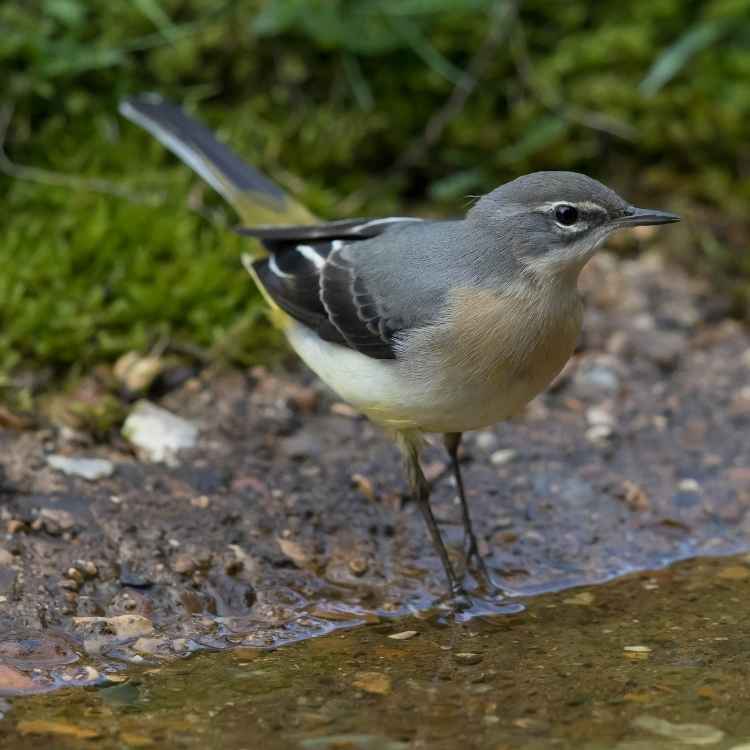
Vireo
Another type of grey bird is known as a vireo–and if there was ever such thing as an “everybird,” these would definitely fit the description! It may seem like this species could not possibly exist because all birds are unique but when you sit down and take a good look at grey vireos, you’ll see how wrong that assumption was. Grey vireo’s grey feathers come in different shades and they have red eyes–so if grey birds with red eyes are what you’re looking for, we’ve certainly got the grey bird species list to meet your needs!
Learn more: https://en.wikipedia.org/wiki/Vireo
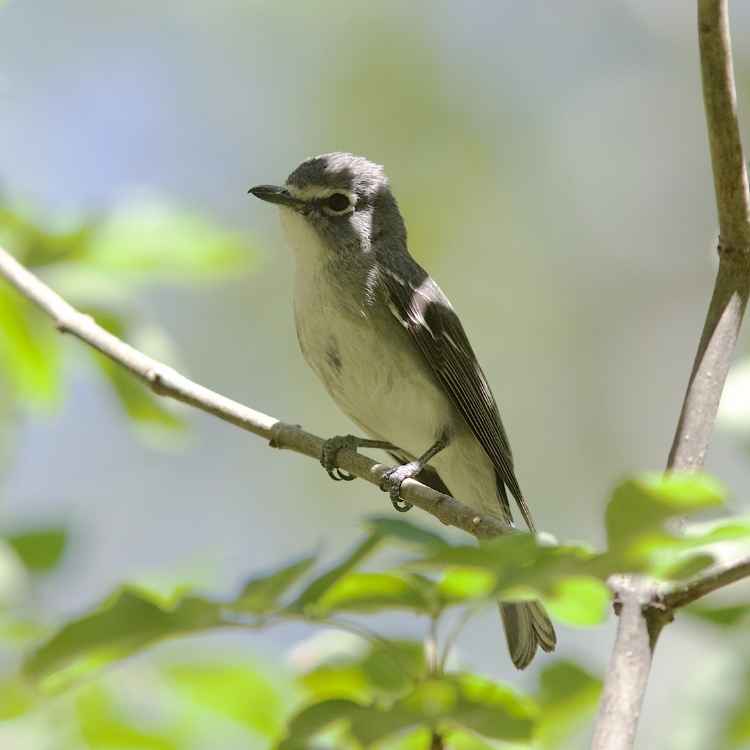
Owls
Next on our grey bird’s list: owl types. Owls are almost always considered nocturnal creatures but there’s one type of owl that loves singing songs while the sun is shining. These grey birds also like warmer climates where people live so it may be harder than usual to spot them (or maybe not). If owls aren’t quite what you were looking for when coming up with ideas about grey lists, don’t worry. We have grey birds that will brighten up your day and grey types of crows for you to consider. But we also talk about owl symbolism on this blog.
Learn more: https://abcbirds.org/blog20/owl-species-united-states/
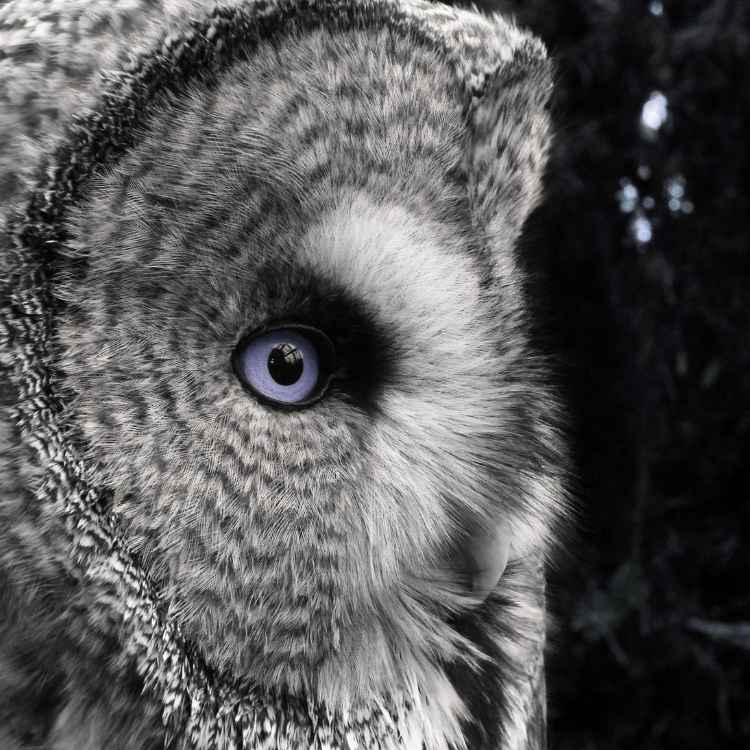
Gray Catbird
Another grey bird is the Gray Catbird. These birds like to mimic sounds which is what makes them so popular among birdwatchers; grey catbirds will even copy other types of grey bird species! In addition, these grey creatures have a tail as well as wings–even though they’re not the best fliers in the world. If you want to be sure you see all types of grey birds before leaving your home this spring, we suggest keeping an eye out for gray catbird sightings near you soon!
See more information: https://www.allaboutbirds.org/guide/Gray_Catbird/overview
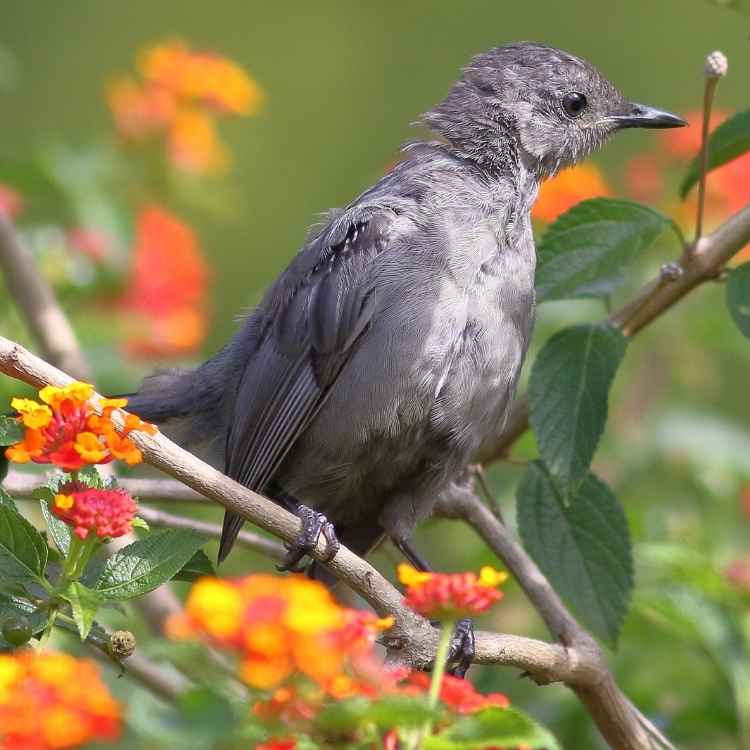
Bushtit
Bushtits look a bit plump and chubby! They’re grey all over and have white bellies while their heads come in different colors–some look like they’ve been dipped in milk chocolate while others seem to have gone swimming with M&M’s attached to their feathers. These grey birds have a unique call and can be found in the western United States. Check also our comparison: Coal Tit Vs Great Tit.
Learn more: https://en.wikipedia.org/wiki/American_bushtit
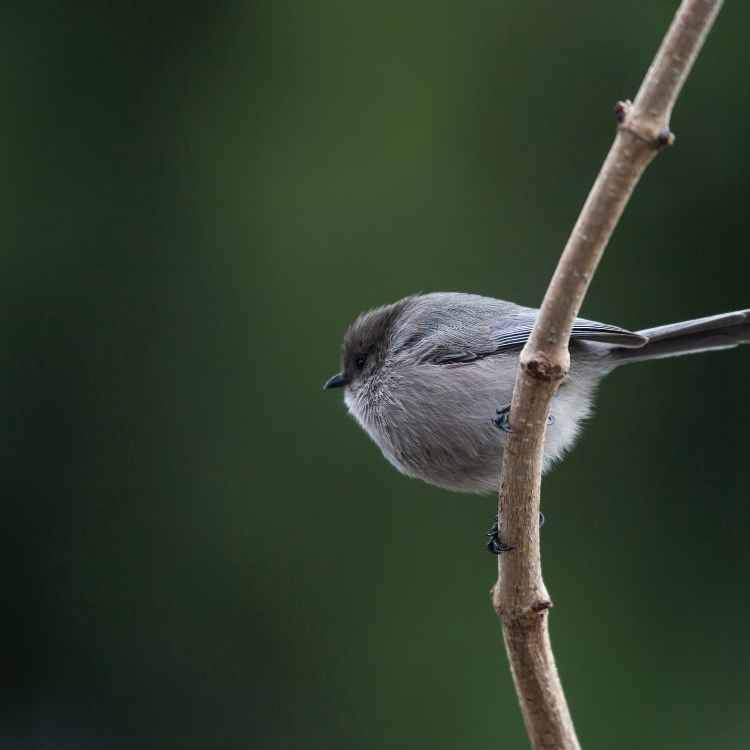
Northern Mockingbird
Next up: Northern Mockingbirds; these grey birds like to imitate other grey bird types and can be found all over the United States. The best time of year to spot a grey mockingbird is spring–most especially if you’re looking for them in Maryland or Washington, DC! In fact, these grey creatures are so popular that they have their own festival every April.
The mockingbird has been known to be a versatile feeder. In the summer, they consume mostly animal prey including earthworms and insects while during wintertime their diet consists almost entirely of fruits!
Mockingbirds can drink from puddles or dew that accumulate on plant leaves; they will also eat berries found at riverbanks as well as seeds sourced deep within forests annually after the fruiting season ends in fall (and sometimes even lizards).
Learn more: https://en.wikipedia.org/wiki/Northern_mockingbird or read our post about the mockingbird symbolism.
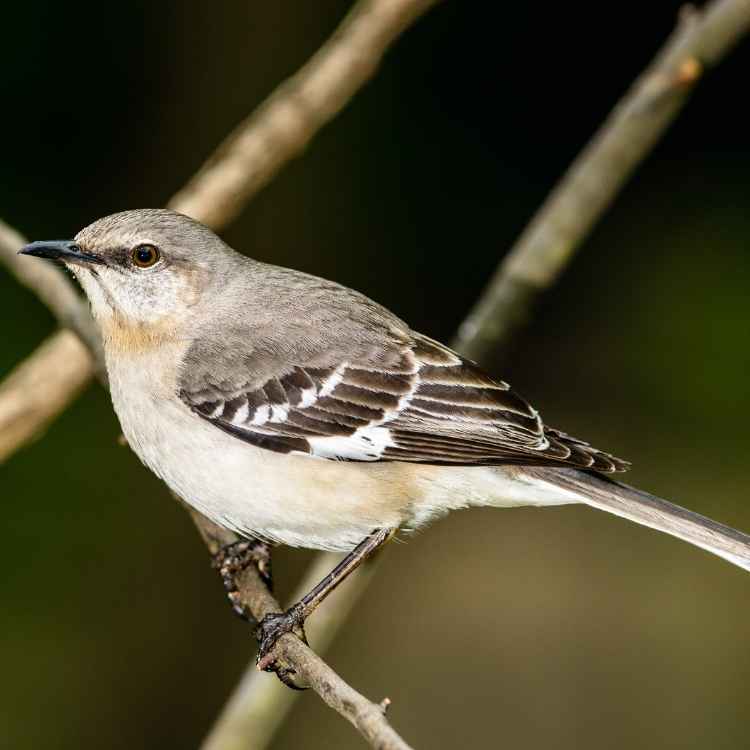
Canada Jay
You might think that the Canada Jay is just an average bird, but it’s so much more than this. The deceptively cute avian species live in northern forests year-round and rears its chicks during winter months when food becomes scarce due to cold temperatures! These clever birds will not hesitate at all before landing on your hand for a raisin or peanut whenever they need something tasty… even if you’re miles away from any type of tree!
Learn more: https://www.allaboutbirds.org/guide/Canada_Jay/overview
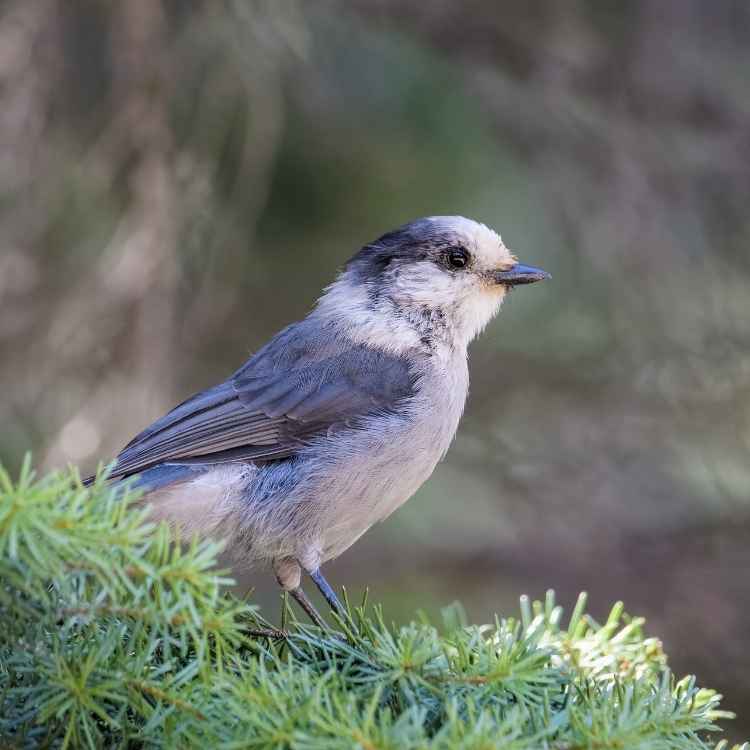
Carolina Chickadee
The Carolina Chickadee is a sociable bird that likes to explore and see what’s going on, but for breeding pairs, they’re more of an acrobatic family member. They like living with other members of their own species as well as some small animals in feeding flocks that roam around within one large area- not too spread out though! Though these guys normally even space themselves while eating so no worries there.
We also put together a comparison of the Nuthatch Vs Chickadee and write about the chickadee symbolism.
Learn more: https://www.allaboutbirds.org/guide/Carolina_Chickadee/id
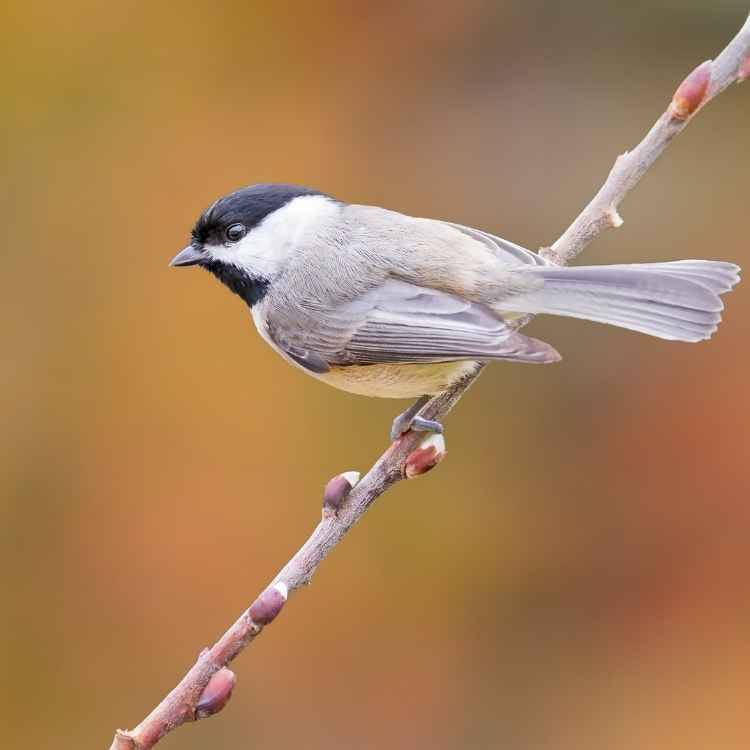
Gray Flycatcher
The drab, pale-gray flycatcher with little plumage contrast; very similar to other flycatchers. This bird is often best identified by its unique habit of wagging the tail down when it’s not in use or hunting for food like insects on vines. The breeding habitat is also distinctive: lower, more open areas than most birds — usually sagebrush steppe mixed in juniper forest at low elevation levels near salt lakes.
The diet of the flycatcher is controversial. It apparently consists entirely of insects and other small invertebrates, but fruit may be eaten in winter if it’s available; otherwise, food includes frogs legs or ants on occasion. Birds are typically very patient flyers as they wait for prey to come near enough before swooping down with their bills wide open – usually from shrubs or low tree branches where there’s an ample supply nearby- though some have been seen hovering over leaves waiting patiently until something passes by too close then grabbing hold quickly so its wings don’t get caught up within reach.
Learn more: https://en.wikipedia.org/wiki/American_gray_flycatcher
Of the flycatcher family, most of the members have grey plumage:
- Gray Flycatcher
- Least Flycatcher
- Nutting’s Flycatcher
- Pine Flycatcher
- Spotted Flycatcher
- Scissor-tailed Flycatcher
- Willow Flycatcher
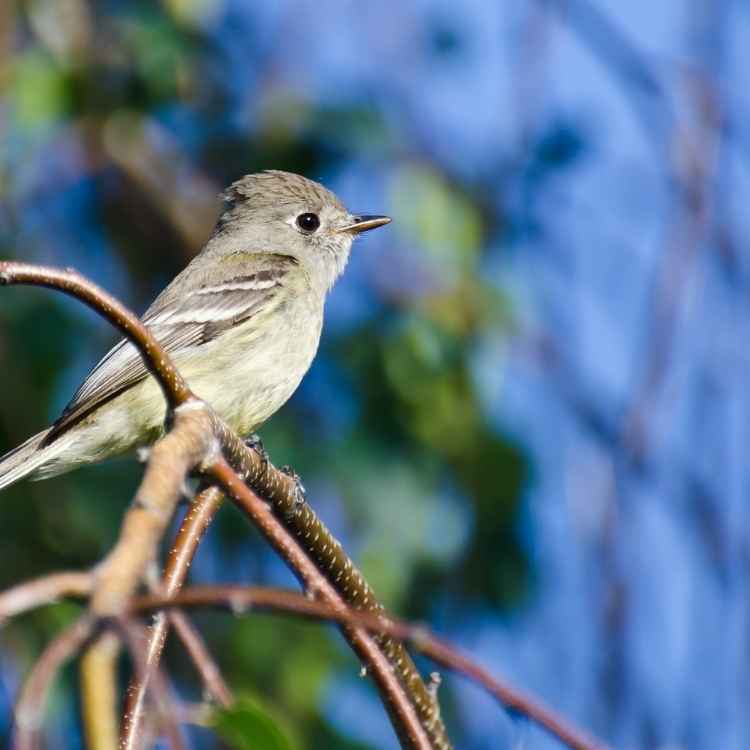
Gray Hawk
Gray Hawk hunting in the forest is a fascinating and beautiful sight, with these raptors often seen perching below or soaring above before swooping down on unsuspecting prey. They’re different from other birds of prey because their flight pattern seems more accipiter-like than eagles’.
Gray Hawks have short wing strokes while gliding; this helps them hunt ground-dwelling animals such as lizards. Their tail feathers also fanned out when they dive for food which creates an eerie effect against dark green leaves underneath mighty oaks – it’s hard not to wonder what kind of mischief might be going on. In case you’re interested, we do have a post about hawk symbolism.
Learn more: https://www.allaboutbirds.org/guide/Gray_Hawk/id
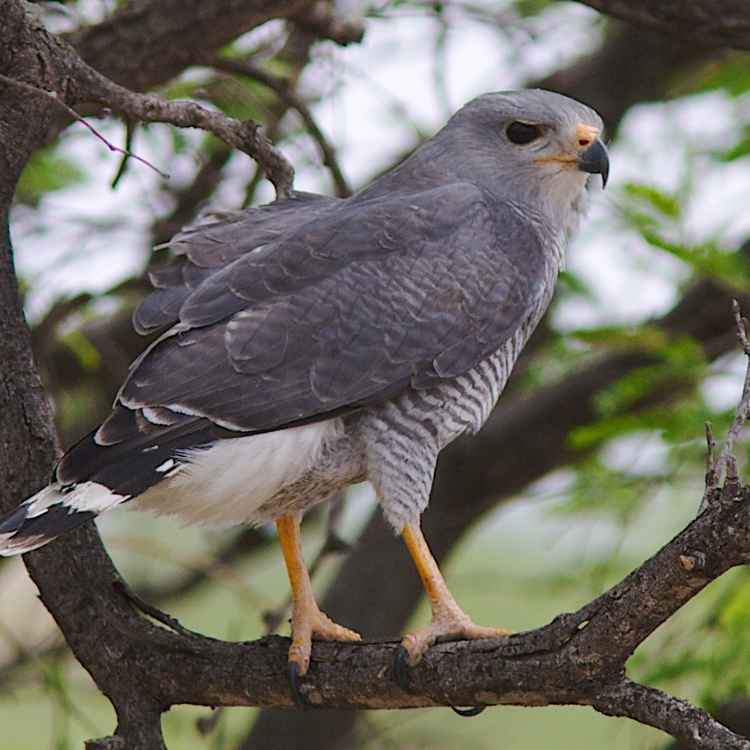
Grey Jay
The grey jay is a grey-plumaged member of the Corvidae (crow) family, with adults having white around their face and throat which extends down to their neck too. These birds are also commonly called Canada Jays or whiskyjacks because they’re found in northern forest regions throughout North America year-round where it’s cold! They live off berries during the summertime before winter sets in so there isn’t much food for them then due to freezing temperatures that make finding something tasty rather difficult – this means these birds have had to adapt accordingly. You may even see grey jays wandering onto your picnic table out on trails if you leave some crumbs behind; they’ll come looking for a snack on their own if you’re not around.
The grey jay is a member of the family Corvidae which includes crows, ravens, and magpies. This beautiful bird can be found across North America in forests where it eats insects off the ground or shoots them out with its bill while foraging amongst other birds’ droppings! Its also known as Canada jay (Perisoreus canadensis), also known as camp robber, or whisky jack!
Learn more: https://en.wikipedia.org/wiki/Canada_jay
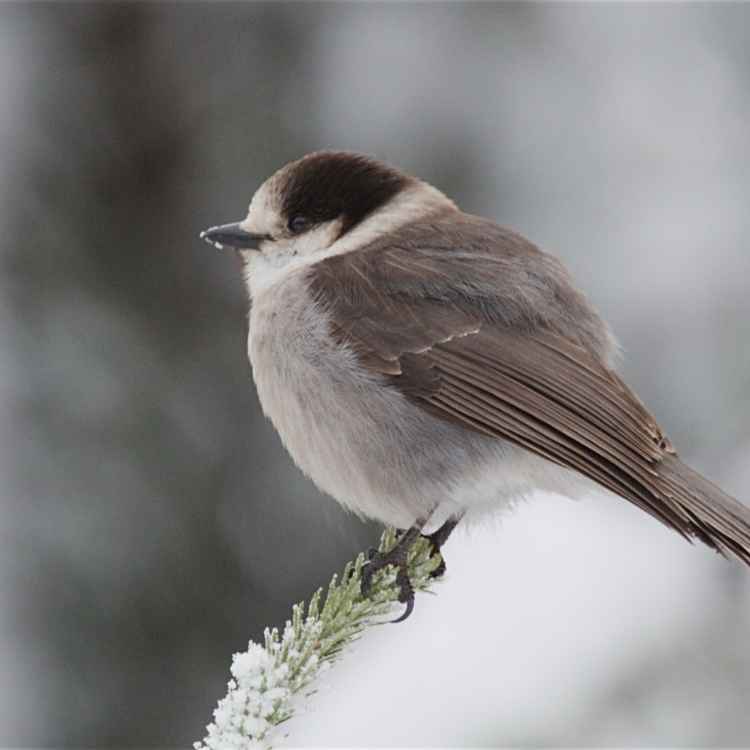
Hooded crow
Not entirely grey, the hooded crow is also known as Scotch crow and Danish crow. In Ireland, it is called caróg liath or grey crow, as its name also means in the Slavic languages and in Danish. It is called “mist crow” (Nebelkrähe) in German, and “dolman crow” (dolmányos varjú) in Hungarian. It’s a member of the family Corvidae which includes crows, ravens, and magpies. The grey hooded crow is found in Africa, Europe, and parts of Asia where it lives among forests near rivers during winter months before migrating to warmer climates by springtime!
The hooded crow is a scavenger and feeds on the same fare as its carrion cousin. The bird has long been known for pilfering eggs from nests without permission, but it doesn’t stop there: this rapacious reveler also enters burrows to steal any food that gets left behind!
Crows are also mysterious birds, hence we talk about them in our post: crow symbolism.
Learn more: https://en.wikipedia.org/wiki/Hooded_crow
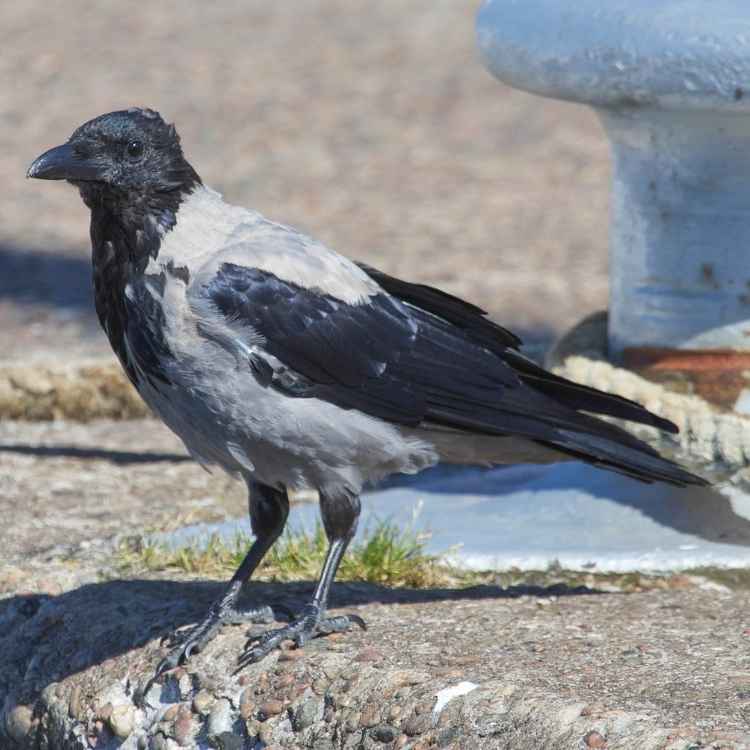
Grey Partridge
The grey partridge is a medium-sized bird with an orange face. It flies through the air and glides for short periods, using its whirring wings to maintain height while it searches out food or other ground-dwelling creatures that may be hiding in tall forests like trees at their sanctuary from danger above them.
The grey partridge is also known as grey pheasant, gray partridge, or French partridge. It’s a member of the Phasianidae family which includes chickens (read more about the chicken symbolism) and quails. The grey partridge lives in the open country across Europe including some parts of Asia where it prefers to make its home on chalky soils near waterways!
Learn more: https://www.rspb.org.uk/birds-and-wildlife/wildlife-guides/bird-a-z/grey-partridge/
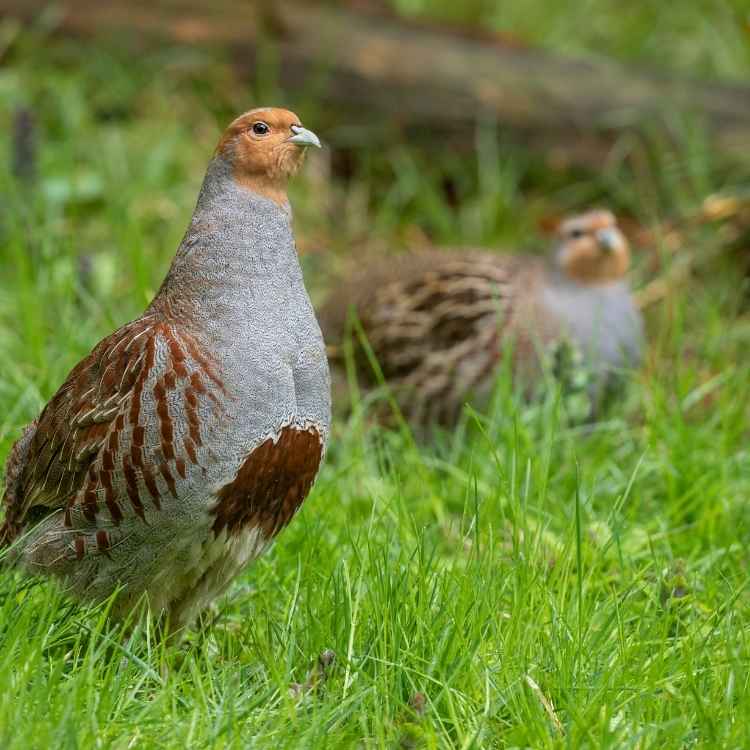
Gnatcatcher
Just like the flycatcher, there are other Gnatchatchers with grey plumage:
The 21 species of small passerine birds in the gnatcatcher family occur naturally across North and South America. Most are residents, but some migrate south during winter to warmer climates- like those found on islands off Mexico’s Pacific coast or Hawaii where they can be hardy enough for year-round living!
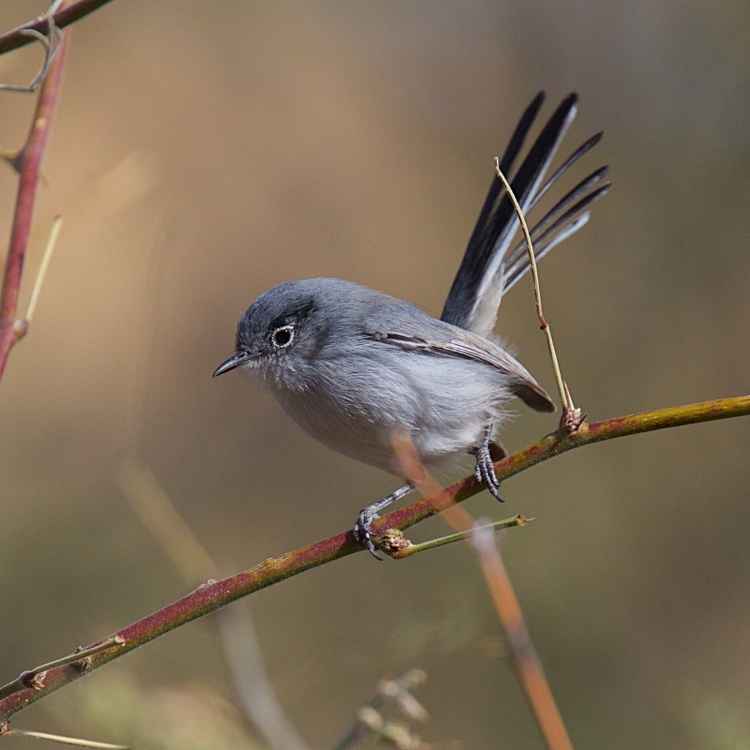
Clark’s Nutcracker
Black and grey with a black bill, the Clark’s Nutcracker is found in western North America! It feeds on pine nuts and conifer seeds – but doesn’t always crack them open so they can germinate. The bird catches up to 98% of its food supply under tree bark or soil to be eaten at a later date as it may not live for long enough if it has built upon cached food too quickly.
Its sometimes also referred to as Clark’s crow or woodpecker crow (read more about two distinct woodpeckers: Downy Woodpecker Vs Hairy Woodpecker). Nutcrackers are clever birds that use their spike-like bills to pick seeds out of pine cones. They often eat some, but then burry thousands for winter food stores in case something happens! These flying creatures flap around on broad wings and make graveling calls audible from afar.
Learn more: https://www.allaboutbirds.org/guide/Clarks_Nutcracker/id
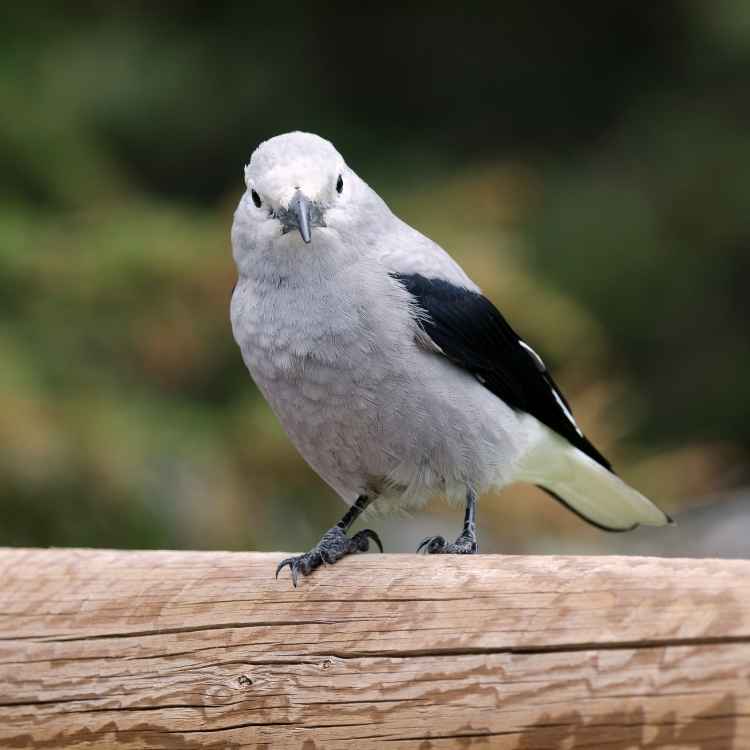
Sandhill Crane
Sandhill Cranes are an awe-inspiring bird that forms giant flocks in the thousands during migration and foraging. They do not hunt like other birds but search out invertebrate prey on dry land or near water sources with their long necks extended forwards while walking slowly through grasslands to find what they need.
The sandhill crane has a unique feeding technique unlike any other creature: its bill slants at nearly right angles from its head so it maxwell penetrate deeper into soft earth which may contain tasty crustaceans hiding beneath thick layers of nutritious mud.
Cranes also play an important role in many cultures, read more in our post about the spiritual meaning of the crane.
Learn more: https://www.allaboutbirds.org/guide/Sandhill_Crane/id
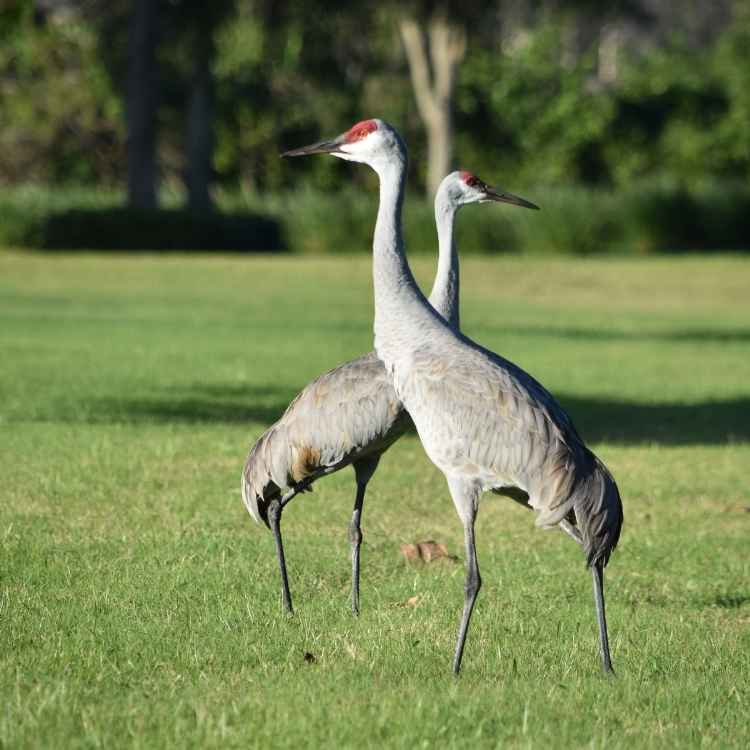
Mourning dove
The grey and white mourning dove is a small and slender bird with grey plumage that has the ability to fly in swift, direct flight when it needs to get away from danger or predators like hawks! It’s one of our most familiar birds because they’re abundant especially in open country along roadsides where there are plenty of natural habitats left around us. They breed prolifically- if we have warm climates which includes farmlands too where farmers use them as crop pests by shooting shotguns at their heads instead of using toxic chemicals for pest control -so long as food sources remain plentiful enough for them to eat while keeping its numbers high enough so both humans and animals can benefit together.
Mourning doves don’t migrate like other grey birds but stay in one area year-round – feeding on seeds, berries, and insects while using its long tail for balance which looks grey at the tip with a white band underneath.
Since the mourning dove is such a ubiquitous bird, we have written a post about it: mourning dove meaning. We also have compared it to its close relative: Turtle Dove vs Mourning Dove.
Learn more: https://www.audubon.org/field-guide/bird/mourning-dove
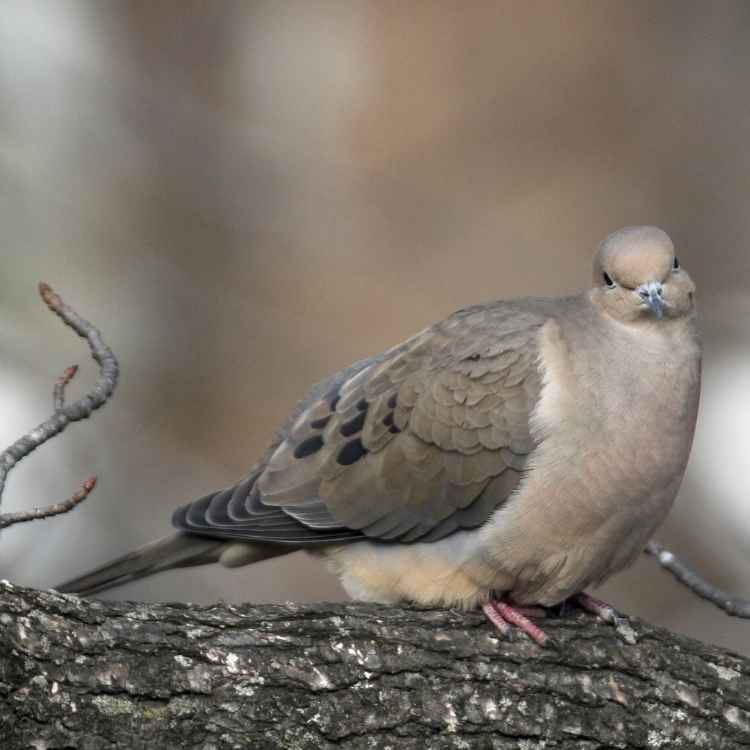
Grey Gull
The grey gull, also known as garuma gull (Leucophaeus modestus) is a medium-sized seabird native to South America. It breeds inland in the extremely dry Atacama Desert of northern Chile but has been recorded from much of the Pacific coastlines south there too! Read more about the symbolism of the seagulls.
Learn more: https://en.wikipedia.org/wiki/Grey_gull
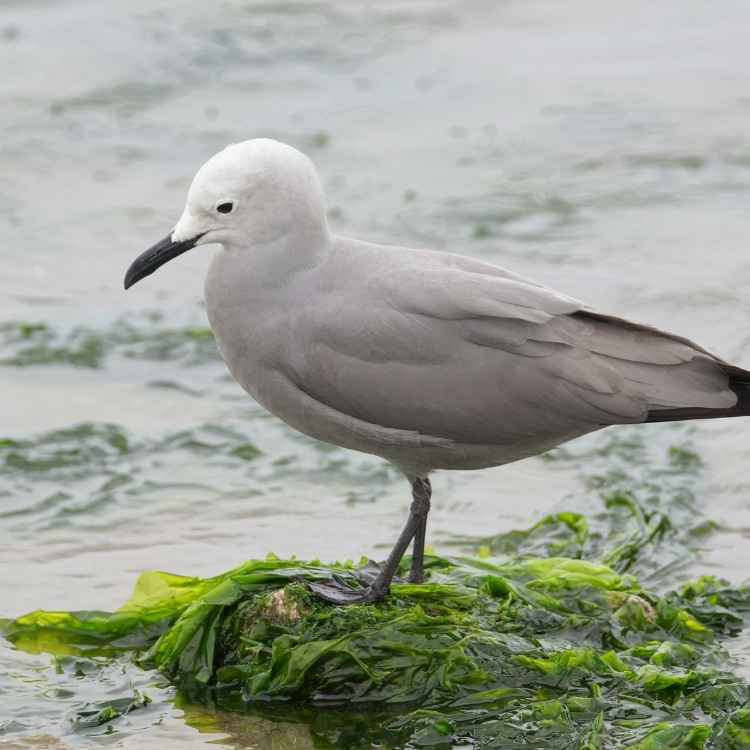
Grey Heron
The grey heron is a long-legged predatory bird that’s native throughout Europe and Asia. It also prefers Africa, but some of its populations live in northern parts near the Arctic Circle during winter months when it isn’t too cold for them (and maybe even gets precipitation!).
The grey heron is grey and white with a long neck and short black beak which it uses to catch fish, frogs, insects, or small mammals like voles. It’s been known to wait motionless for hours until its prey comes close enough that the bird can strike at it quickly before being seen!
The heron also carries a lot of symbolism, read more about it here: heron symbolism.
Learn more: https://en.wikipedia.org/wiki/Grey_heron
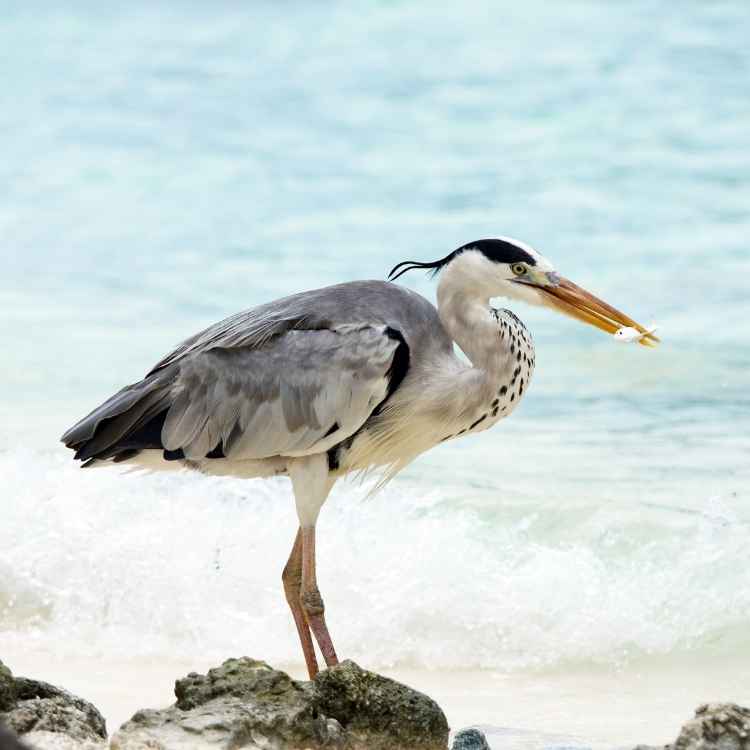
Frequently Asked Questions
What makes grey birds different from other bird species?
Grey birds aren’t boring—they display remarkable variety in plumage shades, markings, and behaviors. Many have distinctive features like yellow beaks, red eyes, or unique vocalizations. Some mimic other species, while others possess specialized hunting or feeding techniques that set them apart from more colorful birds.
How can beginners identify grey birds?
Start by noting distinctive features: eye color (red, white rings), beak color (yellow, orange), belly coloration, tail patterns, and size. Listen for unique vocalizations—chirps, clicks, or mimicry. Location and habitat also help; for example, Grey Wagtails prefer water sources while Bushtits favor western regions.
Which grey birds are known for mimicking sounds?
Grey Catbirds and Northern Mockingbirds are exceptional mimics, copying other bird species and environmental sounds. This behavior helps them establish territory and communicate with mates. Their vocal versatility makes them particularly fascinating for birdwatchers and researchers studying avian intelligence and adaptation.
What’s the difference between Canada Jays and Grey Jays?
Canada Jays and Grey Jays are the same species (Perisoreus canadensis), known by various regional names including ‘camp robber’ and ‘whisky jack.’ These intelligent birds live year-round in northern forests, breed during harsh winters, and fearlessly approach humans for food. They’re adaptable foragers with remarkable survival strategies.
Where can you typically find grey bird species?
Grey birds inhabit diverse environments: wetlands (Grey Herons, Grey Wagtails), western regions (Bushtits, California Gnatcatchers), northern forests (Canada Jays), open country (Mourning Doves, Grey Partridges), and urban areas (Mockingbirds, Chickadees). Seasonal migration patterns vary by species and climate.
What do grey birds eat, and how do they hunt?
Diets vary widely: insectivores like flycatchers snatch prey mid-flight, seedeaters (nutcrackers, finches) crack open seeds, predators (hawks, owls) hunt small animals, and opportunists (crows, jays) scavenge. Many adjust seasonally, eating insects in summer and fruits or cached seeds during winter months.
Are grey birds found worldwide?
Grey bird species occur across multiple continents. While many are North American (Mockingbirds, Chickadees), others inhabit Europe and Asia (Grey Herons, Hooded Crows). Some species like Grey Gulls are endemic to specific regions like South America’s Atacama Desert, showing how grey plumage adapts to various ecosystems globally.
How do grey birds adapt to winter conditions?
Canada Jays breed during winter and cache food year-round. Chickadees have specialized feathers for insulation. Clark’s Nutcrackers store thousands of pine seeds in hidden locations. Mourning Doves and some flycatchers migrate south, while hardy species like nutcrackers remain active throughout harsh seasons using stored resources.
What behavioral traits distinguish grey bird species from each other?
Distinctive behaviors include: territorial singing (vireos), acrobatic feeding (chickadees), tail-wagging while hunting (flycatchers), and intelligence in food caching (jays). Social structures vary from solitary hunters (hawks) to communal foragers (chickadees in flocks), reflecting each species’ ecological niche and survival strategies.
Why are some grey birds more visible during specific seasons?
Migration patterns and breeding cycles determine visibility. Grey Wagtails migrate seasonally to specific regions, breeding pairs become territorial in spring, and winter food scarcity drives some species to populated areas. Northern birds like cranes gather in massive flocks during migration, making them dramatically visible during specific months.
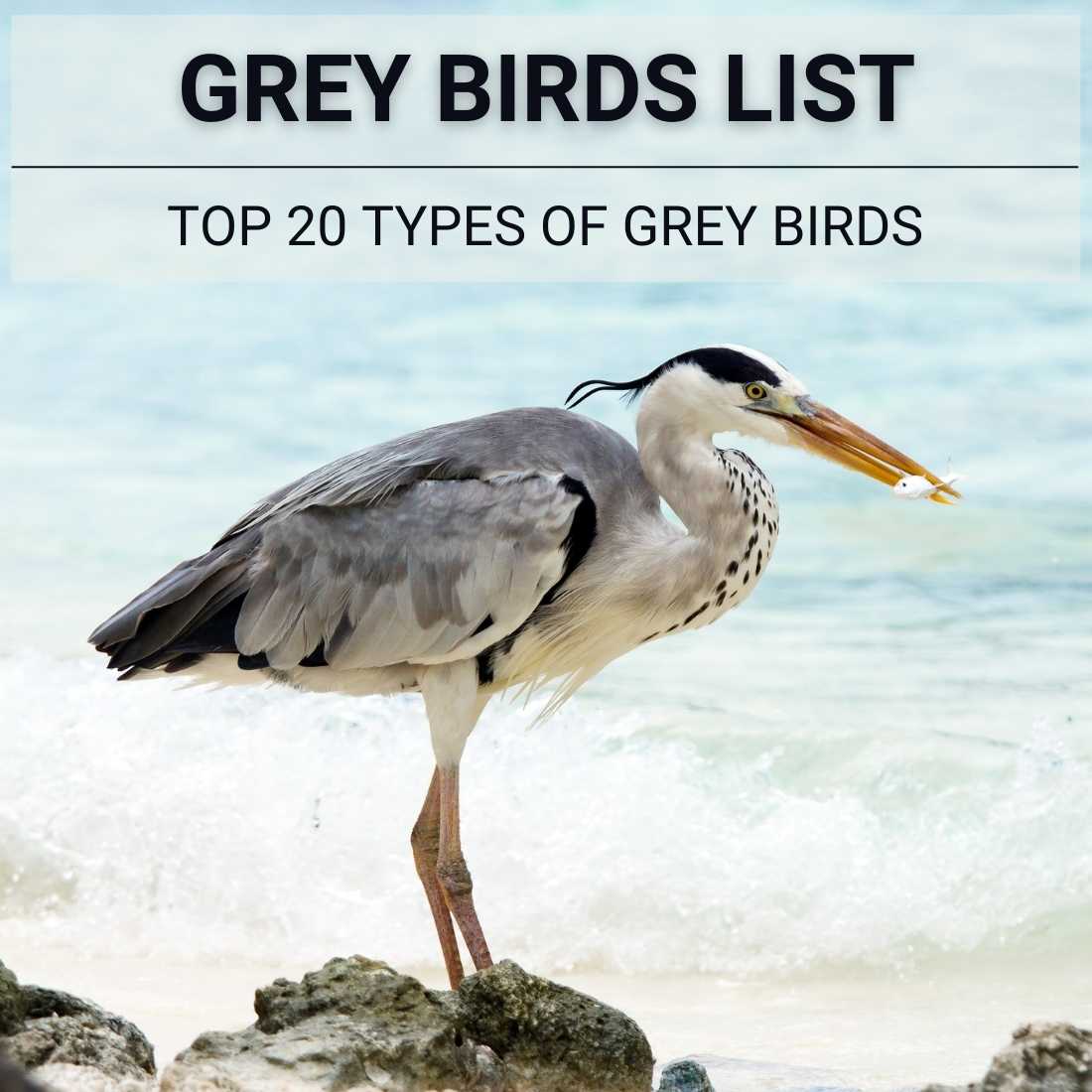

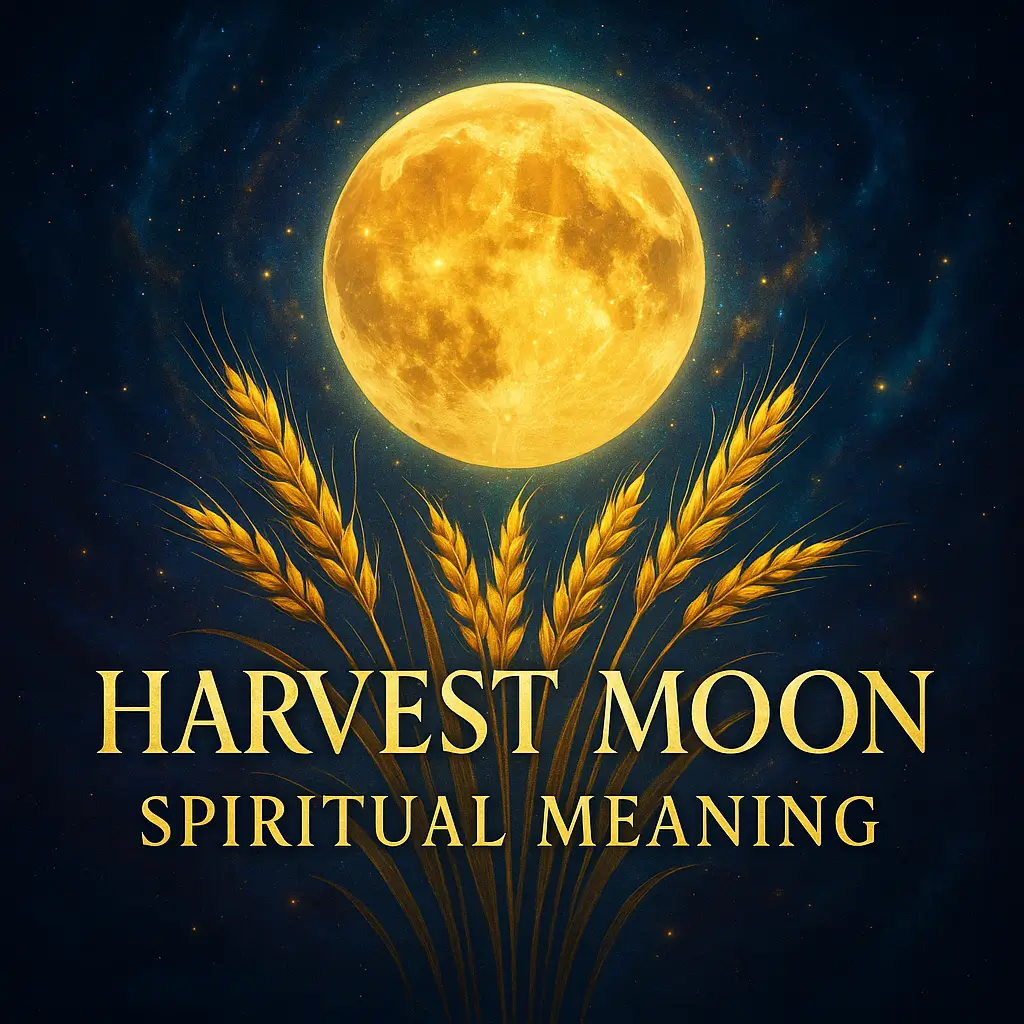

Magnificent list of birds showing its beauty